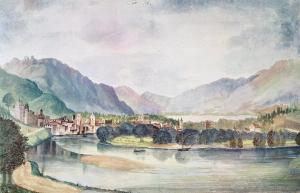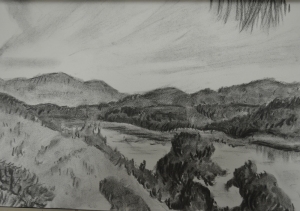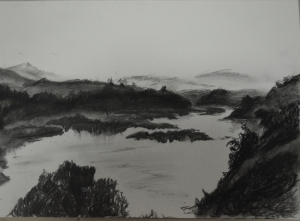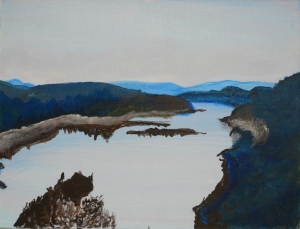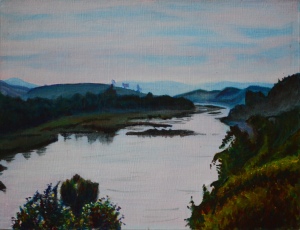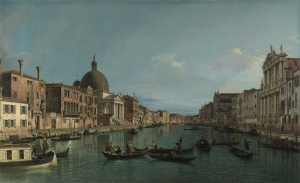
Canaletto – The Grand Canal with S Simeone Piccolo
When I think of think of linear perspective in an urban landscape I think of Canaletto and his paintings of Venice and his wonderful interpretations of the canal systems and architecture.
They used to call Bangkok the Venice of Southeast Asia due to the network of canals in and around the city, most of which have been closed off and made into open sewers. One of these canals is situated behind the Temple school where I teach and so to start this exercise I did rather lengthy study of the canal and the buildings around it,
Bangkok
Canal Behind Debsirin School
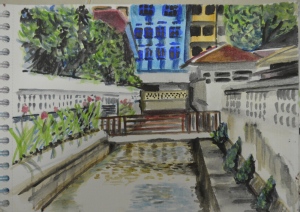
1 Behind Debsirin School – Watercolour
This was the first and probably the best study in this exercise completed from life and in one sitting. I put it together in pieces like a jigsaw drawing the main lines and filling in the details one part at a time rather than drawing the lines of the whole thing first. The plants, bridge and the outhouse at the end of the canal give the painting a lot of depth and it is very much a finished watercolour painting. It would have also been good to paint using really thin washes of acrylic using them as a watercolour medium something I haven’t tried yet.
Wat Makut Temple
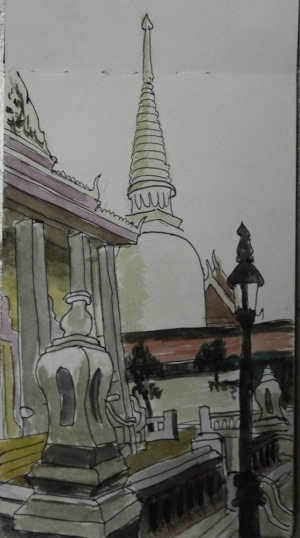
2 Wat Makut Temple – Watercolour and Pen
Continuing with watercolour I went onto make this sketch over two pages in my Moleskine sketchbook of Wat Makut Temple at lunchtime.
This time I completed the expressive outline in Rotring drawing pen before ‘colouring in’ in watercolour. Usually on this style of urban sketching I would lock the sketch in first in pencil before going over in pen but this time I hgave up on the pencil after a couple of lines and completed the rest in pen making it a bit more expressive.
It wasn’t bad and is probably something I would like to develop in the future. However, it would have been better if I had used the book length ways capturing a cropped version scene of both sides of the temple as there are nice buildings on all sides here.
Koh Larn
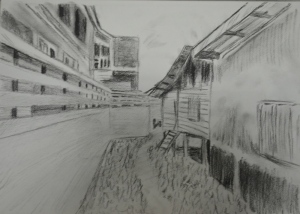
3 Koh Lan Street in Pencil
I loooked all over Koh larn Island for a place where I could sit down undisturbed and spend time sketching without being bothered or being burnt to a crisp. It turned out that the best spot to sketch for this exercise was right near our hotel/guest house where there was a small passage way in between a resort and some traditional Thai island houses that lead down to the beach.
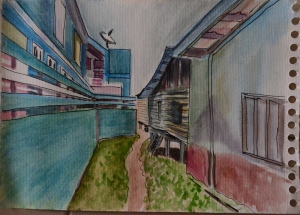
4 Koh Lan in Pen and Watercolour
Here I managed to sit under the corner of a canopy and look down the passageway from the road. The first sketch I made was in charcoal pencil, the second in pen and watercolour. The reason for the two sketches was to see how similar the perspective of the two quick sketches would be, if there weren’t that much difference then I would look at developing these into a painting with the information I had.
The Final Painting
Torn between the Canal at the back of the temple and the scene on Koh Larn I decided to go for developing the scene on Koh Larn to capture the memory, with it being my last year living in Thailand.
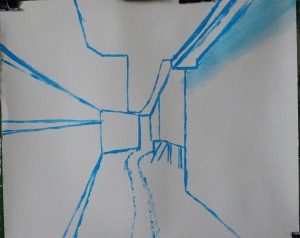
5 Painting the Outline
I started by drawing in the outline by dipping the handle end of the paint brush in a slightly watered down mix of primary blue, hopefully this gave me the same kind of control as drawing with a stick, nice and stiff but not too precise.
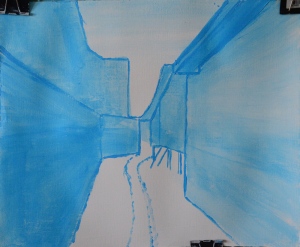
6 Applying the Washes
From there I applied a thin watered down mix of watered down blue fading into the white of the support for the sky and then began to apply thin washes of blue for the buildings.
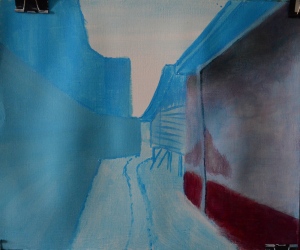
7 Trying a New Technique
The brief for this exercise said that ‘the use of line by drawing with a brush or a drawing medium will be more important than your use of colour and tonal contrast’ but I wanted to use this opportunity to practice a new technique. I don’t know what it’s called or if there’s a name for it but I worked in the paint on the wall of the building in a criss-cross motion working the thin layers of red, blue and burnt Umber on top of each other.
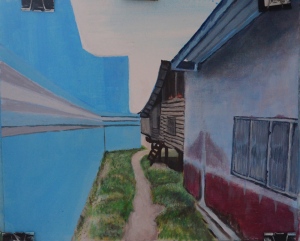
8 Half Way Point
After painting the grass and the sand I carried on working on the lines of the side of the shop and the wooden panels of the Thai houses with a small flat brush before moving onto the resort side of the passageway and the most difficult part, the wooden fence above the wall.
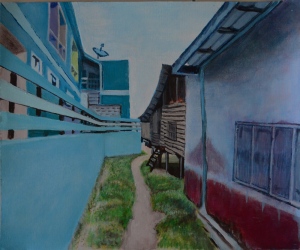
9 Finished Painting
The two sides of the passageway depict a contrast between the traditional lifestyle that the Thais lead and holiday island lifestyle of the visiting holidaymakers and travellers and I was hoping to show that clearly here.
The finished painting is not how I imagined it would turn out. The perspective is good but I imagined it looser and more fluid rather than tight and precise like it turned out. This was due to the left hand side of the painting being quite technical and I would have probably been better choosing a street or passageway with Thai houses on both sides as I like the way the wood on the Thai houses turned out.
The wall on the building on the right remind me of the early paintings of contemporary artist Therdkiat Wangwatcharakul who paints on rusty old aluminium panels, the difference being my finished painting is a bit too clean. Maybe this is because the wall on the right is too clean, would it be better to mark it up in someway?

